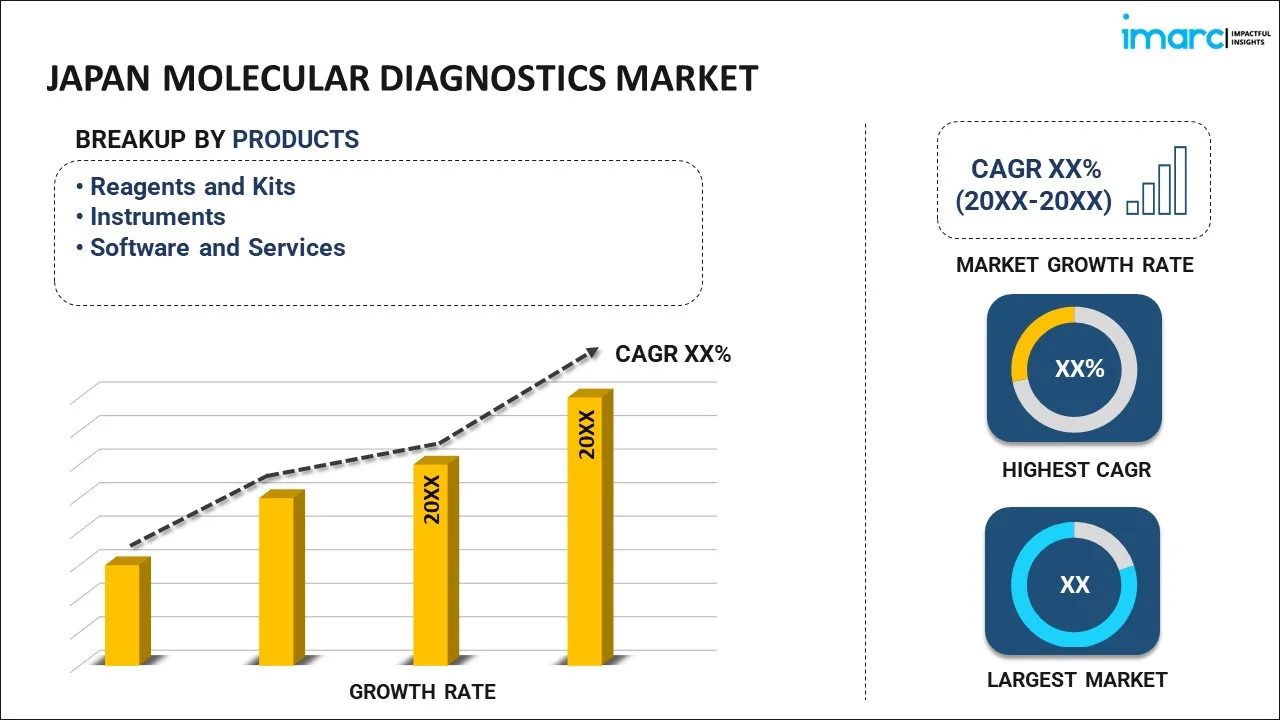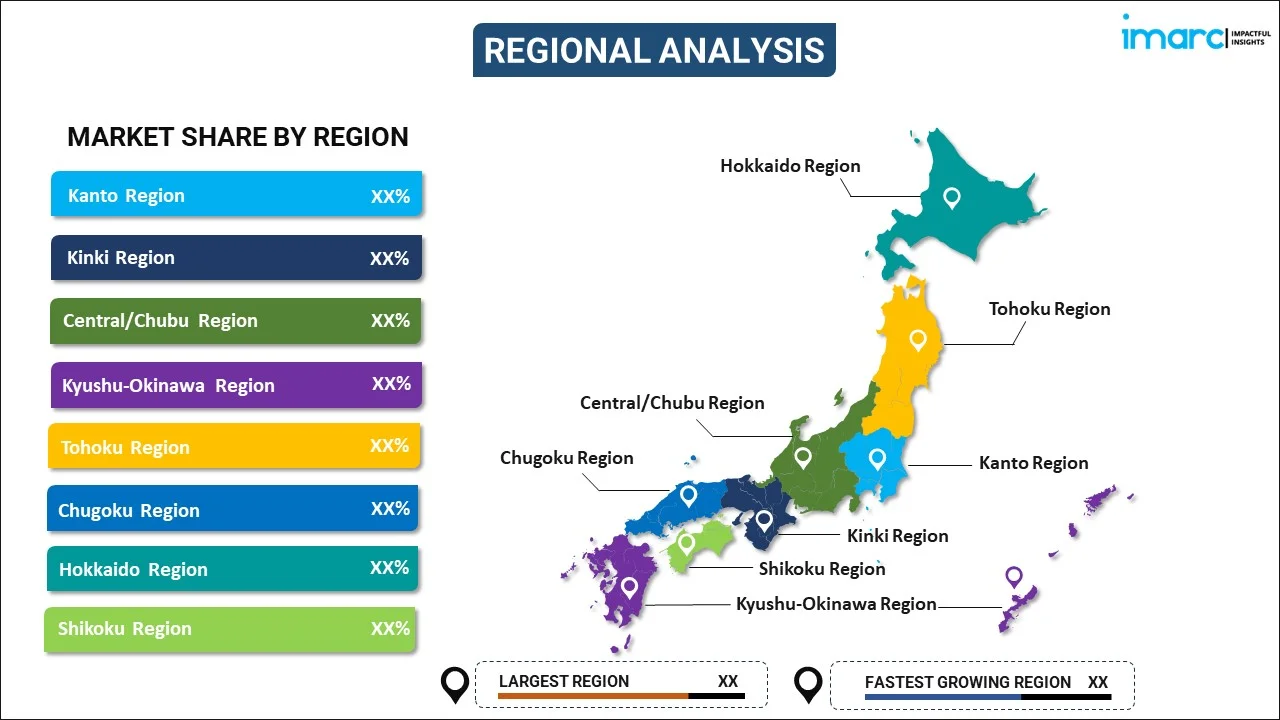
Japan Molecular Diagnostics Market Report by Product (Reagents and Kits, Instruments, Software and Services), Technology (Polymerase Chain Reactions (PCR), Hybridization, DNA Sequencing, Microarray, Isothermal Nucleic Acid Amplification Technology (INAAT), and Others), Application (Infectious Diseases Diagnostics, Oncology, Genetic Testing, Blood Screening, and Others), End User (Hospitals, Laboratories, and Others), and Region 2025-2033
Market Overview:
The Japan molecular diagnostics market size reached USD 1.2 Billion in 2024. Looking forward, IMARC Group expects the market to reach USD 2.1 Billion by 2033, exhibiting a growth rate (CAGR) of 6% during 2025-2033. The increasing prevalence of chronic diseases, including cancer and cardiovascular ailments, the growing geriatric population requiring unique healthcare needs and a higher propensity for specific diseases, and the integration of advanced technologies such as next-generation sequencing and real-time PCR represent some of the key factors driving the market.
|
Report Attribute
|
Key Statistics
|
|---|---|
|
Base Year
|
2024 |
|
Forecast Years
|
2025-2033
|
|
Historical Years
|
2019-2024
|
| Market Size in 2024 | USD 1.2 Billion |
| Market Forecast in 2033 | USD 2.1 Billion |
| Market Growth Rate (2025-2033) | 6% |
Molecular diagnostics refers to a collection of techniques used to analyze biological markers in the genome and proteome. This category of diagnostics enables medical professionals to detect and measure the presence of genetic material or proteins associated with a specific health condition or disease state. Molecular diagnostics are characterized by their precision, accuracy, and speed, as well as their essential role in the healthcare system. These diagnostic methods employ technologies such as PCR (polymerase chain reaction), ISH (in situ hybridization), and DNA sequencing to uncover specific genetic information. Their working mechanism involves extracting, amplifying, and analyzing genetic material, starting with the isolation of DNA or RNA to amplify targeted genetic regions. The amplified genetic material is then examined through various methods to identify mutations or changes, enabling healthcare providers to make informed decisions about diagnosis and treatment. The properties of molecular diagnostics such as sensitivity, specificity, and the ability to process multiple samples simultaneously make them advantageous in providing timely and tailored medical treatments, thereby offering a promising system to personalized medicine.
Japan Molecular Diagnostics Market Trends:
The market in Japan is primarily driven by the increasing prevalence of chronic diseases, including cancer and cardiovascular ailments, which necessitates the need for early and precise detection. In line with this, the growing geriatric population in Japan, requiring unique healthcare needs and a higher propensity for specific diseases, is also providing an impetus to the market. Moreover, the integration of advanced technologies such as next-generation sequencing and real-time PCR is acting as a significant growth-inducing factor for the market. In addition to this, the consistent support from the Japanese government in terms of funding and favorable regulatory guidelines is resulting in a more conducive environment for research and development. Besides this, the growing awareness about personalized medicine, coupled with a strong emphasis on research collaboration between academic institutions and private enterprises, is creating lucrative opportunities in the market. Also, the wide availability of molecular diagnostic platforms across various healthcare settings is impacting the market positively. The market is further driven by the robust investment in healthcare infrastructure and the strategic alignment of public health goals with technological innovation. Apart from this, the penetration of health insurance, focusing on preventive care and early diagnosis, along with the proliferation of specialized laboratories and clinics, is propelling the market. Some of the other factors contributing to the market include Japan's highly educated workforce, sophisticated healthcare system, and a cultural emphasis on precision and innovation in medical science and technology.
Japan Molecular Diagnostics Market Segmentation:
IMARC Group provides an analysis of the key trends in each segment of the Japan molecular diagnostics market report, along with forecasts at the country level for 2025-2033. Our report has categorized the market based on product, technology, application and end user.
Product Insights:

- Reagents and Kits
- Instruments
- Software and Services
The report has provided a detailed breakup and analysis of the market based on the product. This includes reagents and kits, instruments, and software and services.
Technology Insights:
- Polymerase Chain Reactions (PCR)
- Hybridization
- DNA Sequencing
- Microarray
- Isothermal Nucleic Acid Amplification Technology (INAAT)
- Others
The report has provided a detailed breakup and analysis of the market based on the technology. This includes polymerase chain reactions (PCR), hybridization, DNA sequencing, microarray, isothermal nucleic acid amplification technology (INAAT), and others.
Application Insights:
- Infectious Diseases Diagnostics
- Oncology
- Genetic Testing
- Blood Screening
- Others
A detailed breakup and analysis of the market based on the application has also been provided in the report. This includes infectious diseases diagnostics, oncology, genetic testing, blood screening, and others.
End User Insights:
- Hospitals
- Laboratories
- Others
A detailed breakup and analysis of the market based on the end user has also been provided in the report. This included hospitals, laboratories, and others.
Regional Insights:

- Kanto Region
- Kinki Region
- Central/Chubu Region
- Kyushu-Okinawa Region
- Tohoku Region
- Chugoku Region
- Hokkaido Region
- Shikoku Region
The report has also provided a comprehensive analysis of all the major regional markets, which include Central/Chubu Region, Kyushu-Okinawa Region, Tohoku Region, Chugoku Region, Hokkaido Region, and Shikoku Region.
Competitive Landscape:
The report has also provided a comprehensive analysis of the competitive landscape in the market. Competitive analysis such as market structure, key player positioning, top winning strategies, competitive dashboard, and company evaluation quadrant has been covered in the report. Also, detailed profiles of all major companies have been provided.
Japan Molecular Diagnostics Market Report Coverage:
| Report Features | Details |
|---|---|
| Base Year of the Analysis | 2024 |
| Historical Period | 2019-2024 |
| Forecast Period | 2025-2033 |
| Units | Billion USD |
| Scope of the Report | Exploration of Historical and Forecast Trends, Industry Catalysts and Challenges, Segment-Wise Historical and Predictive Market Assessment:
|
| Products Covered | Reagents and Kits, Instruments, Software and Services |
| Technologies Covered | Polymerase Chain Reactions (PCR), Hybridization, DNA Sequencing, Microarray, Isothermal Nucleic Acid Amplification Technology (INAAT), Others |
| Applications Covered | Infectious Diseases Diagnostics, Oncology, Genetic Testing, Blood Screening, Others |
| End Users Covered | Hospitals, Laboratories, Others |
| Regions Covered | Kanto Region, Kinki Region, Central/ Chubu Region, Kyushu-Okinawa Region, Tohoku Region, Chugoku Region, Hokkaido Region, Shikoku Region |
| Customization Scope | 10% Free Customization |
| Post-Sale Analyst Support | 10-12 Weeks |
| Delivery Format | PDF and Excel through Email (We can also provide the editable version of the report in PPT/Word format on special request) |
Key Questions Answered in This Report:
- How has the Japan molecular diagnostics market performed so far and how will it perform in the coming years?
- What has been the impact of COVID-19 on the Japan molecular diagnostics market?
- What is the breakup of the Japan molecular diagnostics market on the basis of product?
- What is the breakup of the Japan molecular diagnostics market on the basis of technology?
- What is the breakup of the Japan molecular diagnostics market on the basis of application?
- What is the breakup of the Japan molecular diagnostics market on the basis of end user?
- What are the various stages in the value chain of the Japan molecular diagnostics market?
- What are the key driving factors and challenges in the Japan molecular diagnostics market?
- What is the structure of the Japan molecular diagnostics market and who are the key players?
- What is the degree of competition in the Japan molecular diagnostics market?
Key Benefits for Stakeholders:
- IMARC’s report offers a comprehensive quantitative analysis of various market segments, historical and current market trends, market forecasts, and dynamics of the Japan molecular diagnostics market from 2019-2033.
- The research study provides the latest information on the market drivers, challenges, and opportunities in the Japan molecular diagnostics market.
- Porter's five forces analysis assist stakeholders in assessing the impact of new entrants, competitive rivalry, supplier power, buyer power, and the threat of substitution. It helps stakeholders to analyze the level of competition within the Japan molecular diagnostics industry and its attractiveness.
- Competitive landscape allows stakeholders to understand their competitive environment and provides an insight into the current positions of key players in the market.
Need more help?
- Speak to our experienced analysts for insights on the current market scenarios.
- Include additional segments and countries to customize the report as per your requirement.
- Gain an unparalleled competitive advantage in your domain by understanding how to utilize the report and positively impacting your operations and revenue.
- For further assistance, please connect with our analysts.
 Inquire Before Buying
Inquire Before Buying
 Speak to an Analyst
Speak to an Analyst
 Request Brochure
Request Brochure
 Request Customization
Request Customization




.webp)




.webp)












